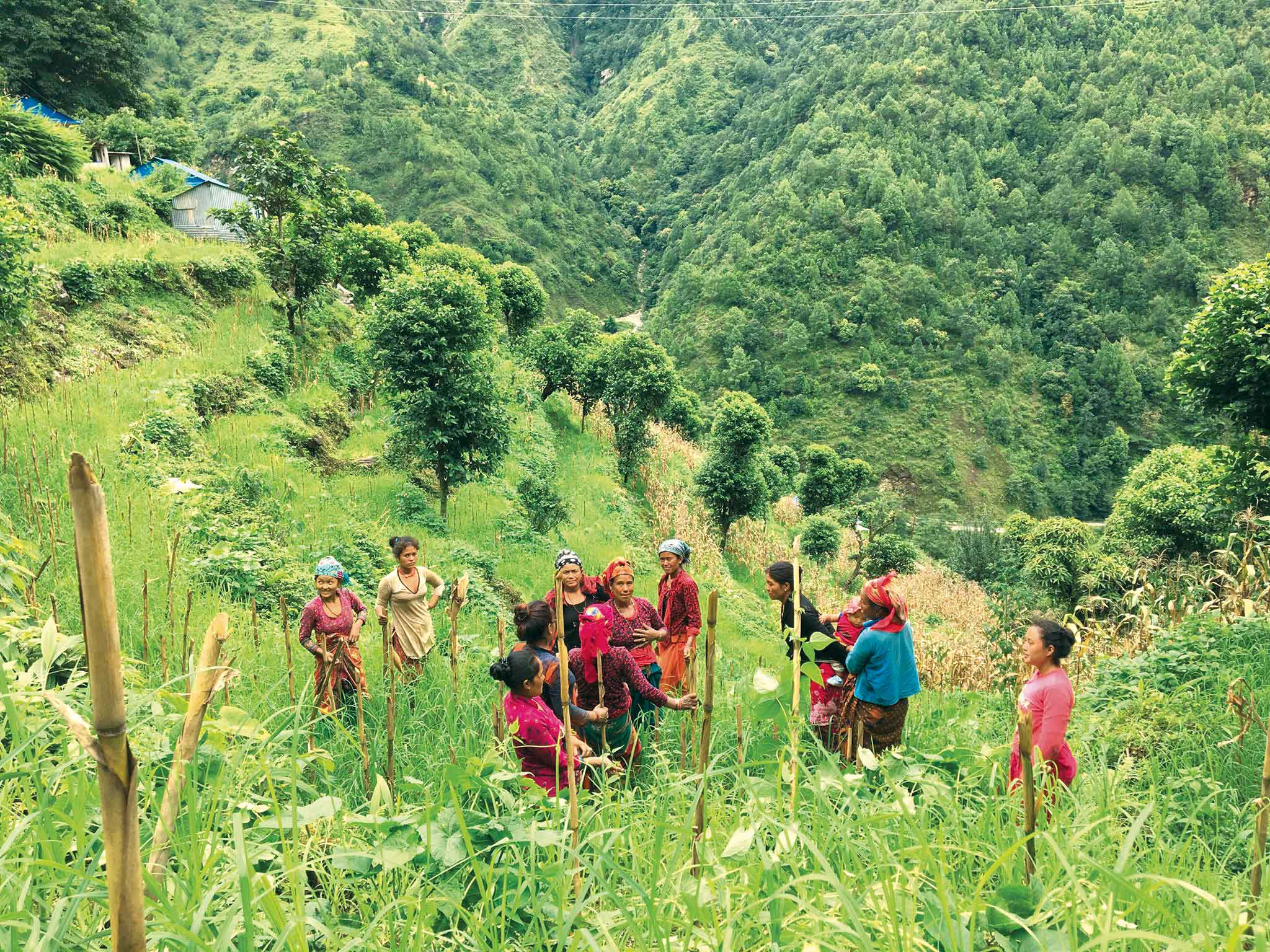Through film, a Nepali village begins to grapple with domestic violence
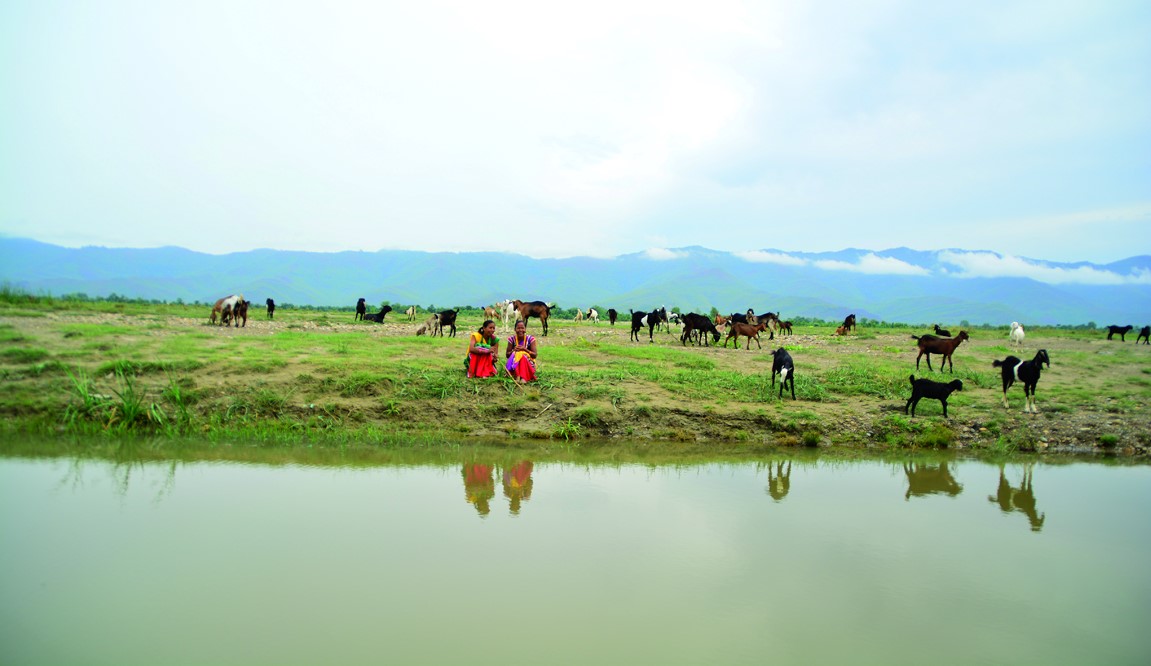
For two years in 1989 and 1990, Damian Jones lived in Ratanpur, a village in the Deukhuri valley of Dang district, in mid-western Nepal. An American Peace Corps Volunteer then in his 20s, Jones taught primary-level math and science at the nearby Saraswoti Secondary School, one of only a handful of schools in the valley at the time. Ratanpur was small and isolated; there was no electricity, and the roads were far away and poor. The villagers, who all belonged to the Tharu ethnic group, lived in long, mud-wattle homes that housed multiple generations and extended families under a single thatched roof. Jones lived in a loft above a cow shed; he was the only person in Ratanpur who lived alone.
But Jones was not lonely. He took his meals with the village leader’s family, and after school, students often came to his room to play or do homework, or chat with Jones in the Tharu language, which he learned to speak along with Nepali. Much social and community life revolved around two annual festivals: Maghi, or Tharu New Year, in the short, brisk days of winter; and Dashain, celebrated in the fall, when the rice fields began to turn golden brown and the sky sparkled a crystal blue. Jones loved to partake in the festivals’ communal dances and improvised public theater—a tradition known in Tharu as soung, when villagers performed humorous skits.
After finishing Peace Corps service, Jones maintained ties with Ratanpur. He worked on health projects for several years elsewhere in Nepal, and visited often. After the projects expired, Jones returned to the United States. Desiring to maintain his connections with Nepal, he began exploring the field of socially responsible handicraft importing. At first, he struggled financially, taking out loans and selling items from Nepal from the back of his car while driving up and down the East Coast of the United States. But, eventually, he developed strong partnerships with American handicraft retailers, and Aid Through Trade, as his business is known, became fair trade-verified in 1994. Today, the company creates original necklace and bracelet designs that they produce in collaboration with about 200 female artisans in the Kathmandu and Deukhuri valleys, including in Ratanpur. Many of the artisans in the Deukhuri valley are Jones’s former students or friends.
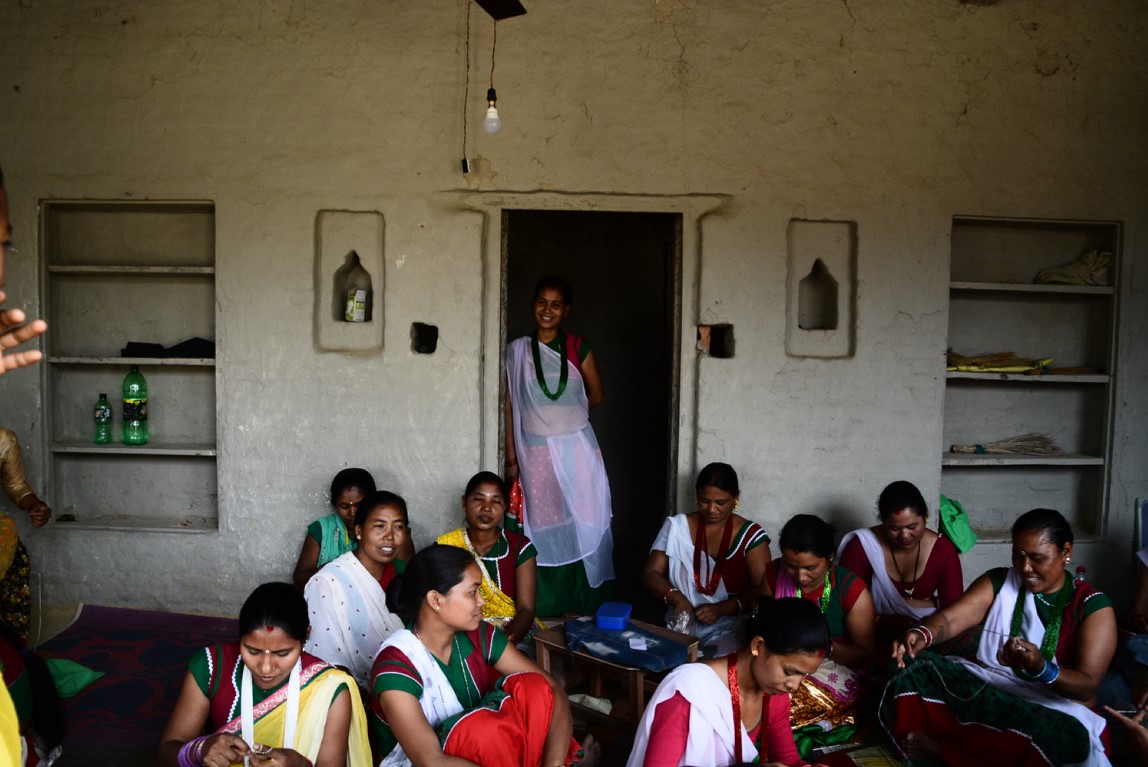
On a visit to Deukhuri valley in 2017, Jones, who lives in Maryland, made a troubling discovery. He was in the midst of interviewing the artisans to produce profiles for the company’s web page when he learned that one of the women had been severely beaten by her husband. Jones began to ask the other artisans about their experiences, and found that roughly every third woman had experienced spousal violence.
This shocked Jones, because he believes such violence was rare when he was a Peace Corps Volunteer. “I can't believe that it would have been at the level it is now, and I wouldn't have noticed more of it. Living there every day for two years, eating, sleeping, going to school, teaching—I can't believe that I wouldn't have heard more about it,” Jones, who has a boyish face despite now-graying hair, told me.
One young woman made an unusual request. “’Sir, eske lake ek tho chaki nan dyo,’” she said, according to Jones. “Meaning, ‘for this [domestic violence], please bring us a pill [to give to the men].’" Jones told her he knew of no medicine to prevent violence, but her question played over in his mind. After returning to the U.S., he had an inspirational dream one night. (Jones often records his dreams, and has been a student of Jungian dream analysis for 25 years.) In the morning, an idea clicked. “It was right there: I should go back and make a film about this.”
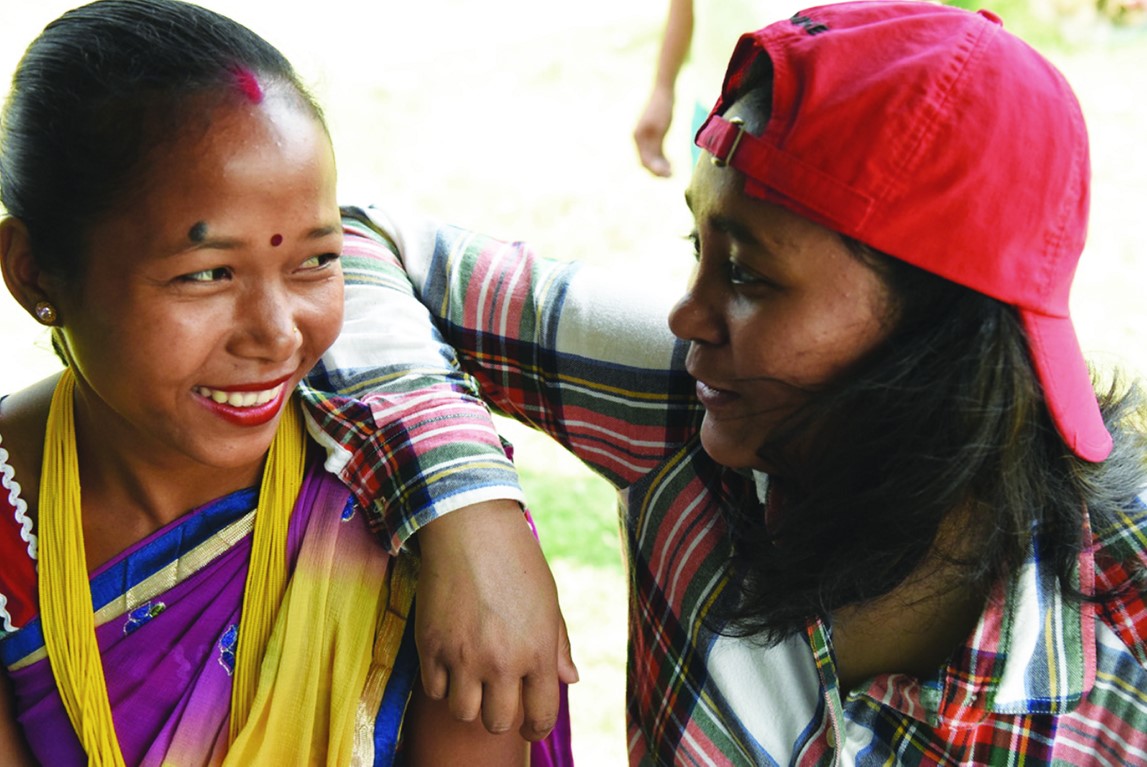 In early 2018, some friends (full disclosure: one of those friends was me) introduced Jones to Keshab Pandey, a film-maker and director based in Kathmandu. Via email, Jones pitched Pandey his idea: he wanted to create a short feature-film telling a story focused on domestic violence. The characters would be played by the female artisans in Ratanpur. Eventually, he wanted to show the film in Ratanpur and nearby villages, in order to “bring the topic of gender based violence to the level of conversation, and foster societal intolerance and intervention.” He shared some additional objectives: “Have fun. Be surprised what is created. Make something captivating.”
In early 2018, some friends (full disclosure: one of those friends was me) introduced Jones to Keshab Pandey, a film-maker and director based in Kathmandu. Via email, Jones pitched Pandey his idea: he wanted to create a short feature-film telling a story focused on domestic violence. The characters would be played by the female artisans in Ratanpur. Eventually, he wanted to show the film in Ratanpur and nearby villages, in order to “bring the topic of gender based violence to the level of conversation, and foster societal intolerance and intervention.” He shared some additional objectives: “Have fun. Be surprised what is created. Make something captivating.”
Jones explained that he had discussed the idea with the women and would cover the project’s costs if Pandey and his team could volunteer their time.
Pandey is in his 40s and short, with a personality that alternates between sarcasm and earnestness. He had directed feature films and television advertisements (the Nepali 2014 World Cup Coca-Cola ad was his), but he had never worked on a project using only non-professional actors. The idea intrigued him. He proposed to Jones that they travel to the village together, interview the women about their experiences, and then write a script in-situ based on the women’s inputs.
Pandey later explained to me why this approach was important. “If we had written the script before coming to the village, there would have been a different perspective; we could have put our ideas above theirs,” he said. “We wanted to work using their ideas.”
Pandey recruited six of his former students from Oscar International College of Film Studies in Kathmandu—a cinematographer, a sound designer/ recordist, an assistant director, and three other assistants, all in their 20s—to volunteer as well. In April, Jones flew from the U.S. to Kathmandu, and then he, the film crew, and one other colleague and I set off for Ratanpur.
The Deukhuri valley, in which Ratanpur is located, is a long, narrow plain between the Mahabharat and Churia ranges, a day’s drive from Kathmandu. The Rapti River cuts a path from east to west through the middle of the valley, following the daily journey of the sun. Irrigation canals spring from the river’s edges, watering fields to its north and south.
The valley is home to the Tharus, who are indigenous to the area, although beginning in the 1960s, other groups from the hills (many of them so-called “high-castes”) began to settle locally, attracted by the valley’s fertile soils and the eradication of malaria. The new arrivals bought and sometimes stole land from the Tharus, and cut down forests to make way for new farmland. Today, the central valley floor is largely forest-less, although there are scattered orchards of mango and lychee, and shade trees like neem and the lofty simal.
Ratanpur lies to the south of the Rapti, in an area that was historically more remote than the river’s north side, where the East-West Highway has provided connectivity since the 1980s. However, the local road and bridge network has improved significantly since Jones was in the Peace Corps, and electricity arrived in Ratanpur about a decade ago. Like most local Tharu villages, its several dozen homes are built along a north-south axis. As incomes have risen, traditional homes made from mud and wattle are gradually becoming outnumbered by brick and cement houses.
Among the team that travelled from Kathmandu was Shree Prasad Chaudhary, a former student and close friend of Jones’s from Ratanpur who now lives in Kathmandu and helps manage Aid Through Trade’s business operations. Chaudhary is built like a wrestler, but speaks softly and laughs often. Arriving in Ratanpur in the evening, the team settled into Chaudhary’s family home, which is occupied by his older brother, who farms and runs a small business with his son renting out two tractors.
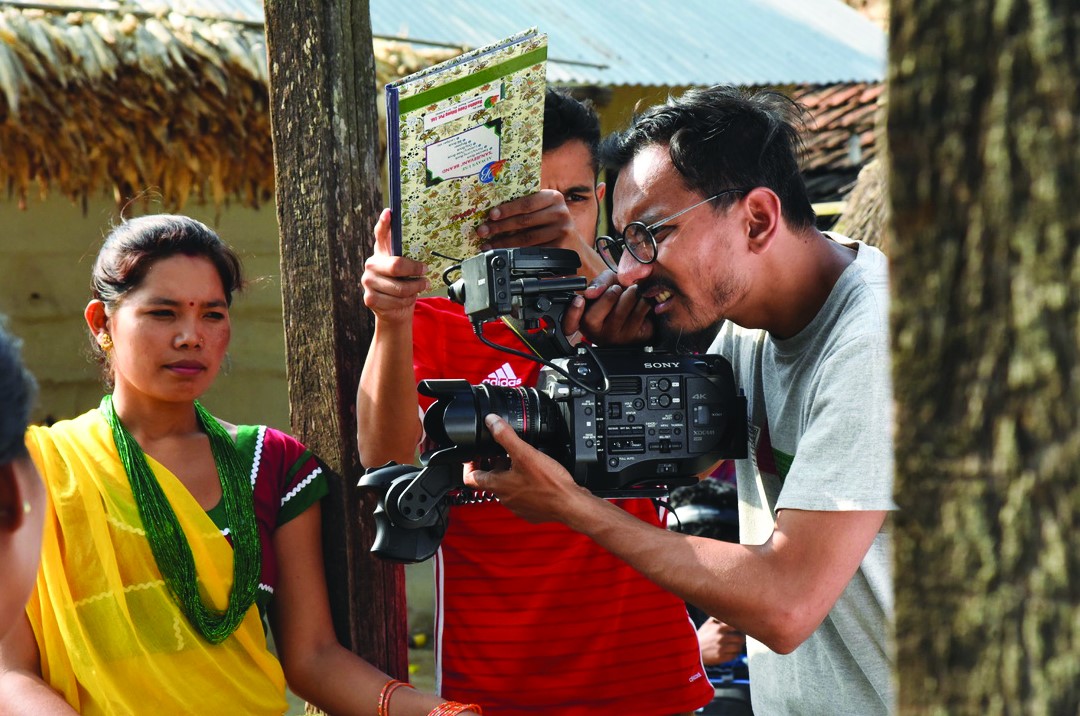
Chaudhary’s sister- and niece-in-law welcomed the guests with drinks and snacks, which they served on a large wooden table in the back yard, under an old mango tree. There was dhikri, a Tharu dish made from steamed rice flour, fried fish, pork, and local alcohol distilled from the flower of mahuwa tree. After dinner, the guests retired to their rooms, crawled under their mosquito nets, and fell fast asleep.
Over the next few days, Jones and Pandey’s assistant director, a young woman named Rajeela Shrestha, interviewed Aid Through Trade artisans about their experiences with domestic violence. The women meet daily and, sitting on stools or on mats on the floor, thread tiny glass beads onto strings that they then weave to produce complex and beautiful designs. As they worked, they shared stories of abuse at home.
The stories were disturbing, but sometimes also humorous. One middle-aged woman said that her husband, an alcoholic, used to frequently beat her. Amid much laughter from the other women in the room, she described a morning after a night of drinking and brawling, when her husband woke up and told her that his eye itched. He asked her to look at it for him. Surreptitiously, she squished a chili pepper in her fingers before examining his eye, and when she did, he howled in pain and ran off and was not seen for hours.
When Jones asked whether she and her husband still loved each other, she said, “What love? He beat me. There’s no love.”
A slender woman named Shanta Chaudhary spoke softly, flashing a beautiful smile. She said she was 28 and that her family had been urging her to marry, but she had steadfastly refused. She had seen too many marriages go awry.
“Boys do all sorts of things to convince the girls,” she said. “They give them dreams of having everything. But actually, once they are married, they treat them poorly, and they fight.”
Still, Shanta said that eventually, circumstances would probably force her to marry. While the artisan work provides a decent income, it wouldn’t be viable in her old age, she felt, once her eyesight weakens. With only a high-school education, she foresaw few other career prospects. Marrying could provide economic security.
She related a story about an older aunt who had struggled to survive as a single woman. The aunt had stayed with her brothers, but they never fully accepted her as part of the family, and when she fell ill, they didn’t take her to a good hospital. When she died, no one performed the 13-day full Hindu funeral rites.
“And I worried, ‘Will this also happen to me?’” Shanta said.
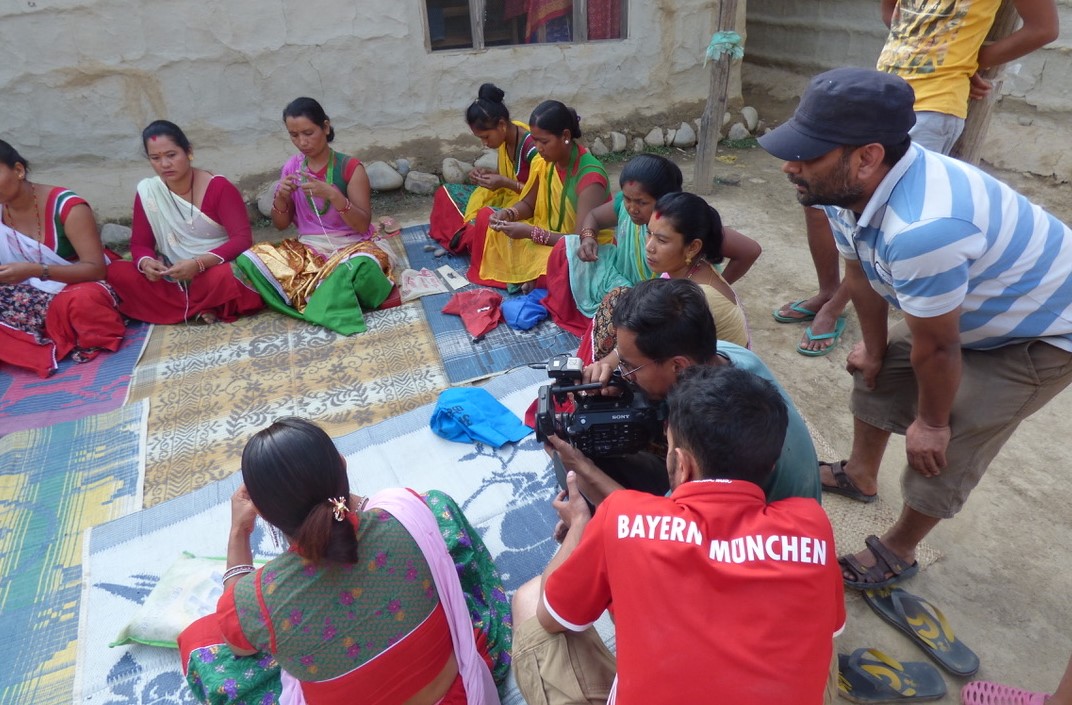 Pandey’s film team was all male, except for Shrestha, and there were no Tharus among them. This complicated sensitive discussions, but Shree Prasad and Jones acted as intermediaries, speaking to the women in earnest tones in Tharu, translating and clarifying. For his part, Pandey tried to lighten awkward moments with a self-deprecating joke or two.
Pandey’s film team was all male, except for Shrestha, and there were no Tharus among them. This complicated sensitive discussions, but Shree Prasad and Jones acted as intermediaries, speaking to the women in earnest tones in Tharu, translating and clarifying. For his part, Pandey tried to lighten awkward moments with a self-deprecating joke or two.
The artisans also had a question for Jones: would there be dancing?
Jones immediately said yes. (“Of course, all films have dancing, right?” he later explained.) The film crew agreed. Together, they decided on a traditional dance: the “Barkha Naach,” or the “Big Dance” of Dashain, which hadn’t been performed in Ratanpur in decades.
During the afternoons before shooting began, the women practiced the dance in a village courtyard, accompanied by a local man who sang and played the two-sided madhara drum, made from wood and goat skin, which he beat with his hands. The dance has a couple dozen different drum patterns, each with their own set of steps. The older women instructed the younger women, who giggled and avoided eye-contact with other villagers who showed up to watch.
Among the audience was a thin, white-haired woman with a weathered face and high cheekbones who used a cane. Each afternoon, she slowly walked across the village and positioned herself under a tree in the courtyard. She told me she had been a dancer and a singer herself when she was young, and was happy to see the Barkha Naach finally performed again.
In the evenings, the film crew sat under the mango tree behind Shree Prasad’s home, snacking on more pork and drinking with their hosts. Hari Prasad, Shree Prasad’s brother, joked about the crew’s city-boy habits (one of the cinematographers had packed jeans and a denim jacket despite the heat), and the team hatched pie-in-the-sky plans to open up a mahuwa distillery in Kathmandu, amid many laughs. They discussed what they had learned during the day and began to shape the film’s plot.
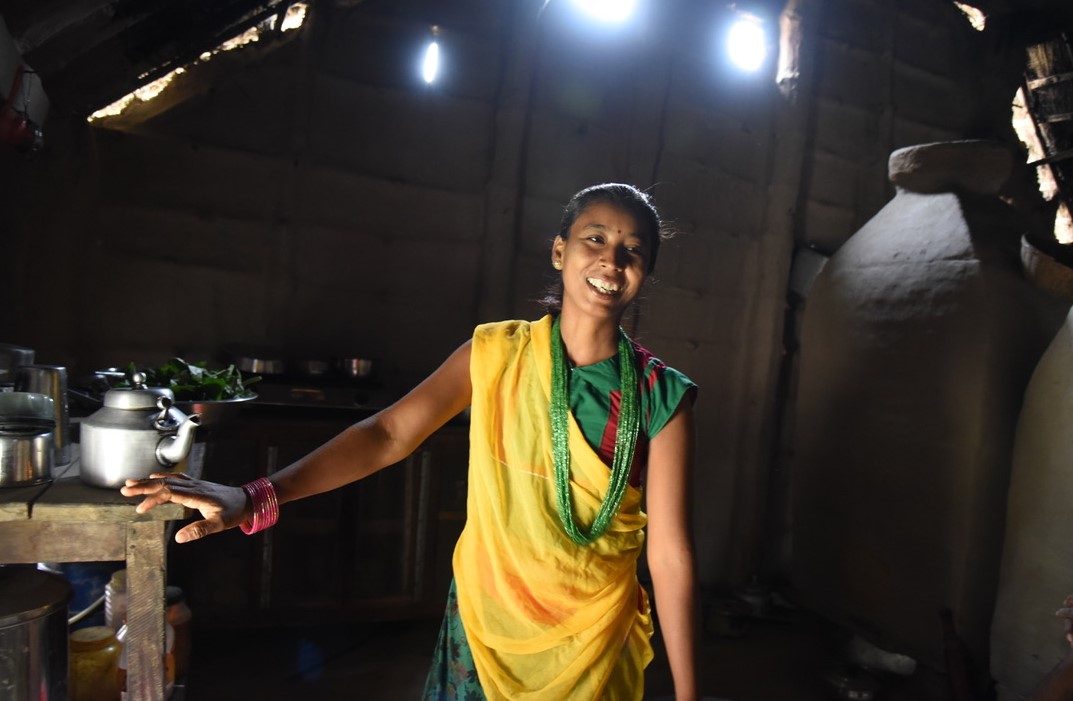
On their fourth night in Ratanpur, the team shot the film’s first scene. In it, a young bride has returned to her natal home for her first visit with her parents after the wedding. The woman— known in the film only by her nickname, “Babuniya”—overhears the dull thuds and terrified screams of a woman being beaten in her neighbor’s home. Shaken, Babuniya falls into an uneasy sleep. She has a nightmare: a shadowy figure approaches her, raises a fist, and…the screen goes black.
The filmmakers chose an artisan named Shila Tharu to play Babuniya. She looks even younger than her 20 years, and her face betrays an innocence they say was one of the reasons they cast her for the role. She told me she had been married for a little over a year and had never been beaten herself, though her older sister-in-law had been.
In the second scene, Babuniya awakens in the morning and goes to fetch water from a well in the center of the village, under a flame tree that Jones and his students planted years ago. Babuniya meets three older women—all dressed in their finest, brightly-colored lehenga-kurta—who also overheard the previous night’s beating. The older women gossip in Tharu about the violence, but are not surprised by it.
Through the course of the day, Babuniya goes about her daily work—taking grain to the mill, feeding the animals, weaving bracelets with her artisans group—and overhears the women she encounters talk about their experiences being beaten. She learns that it is much more common than she had ever thought, and worries that her husband, too, will one day turn on her.
When Babuniya visits her artisans’ group, the women discuss what can be done: “It’s not just that house’s business, it’s the community’s business,” one woman says.
Another comments, “It affects not just the woman who is beaten; it affects her children, and it affects my children, and you know what? It affects all of us.”
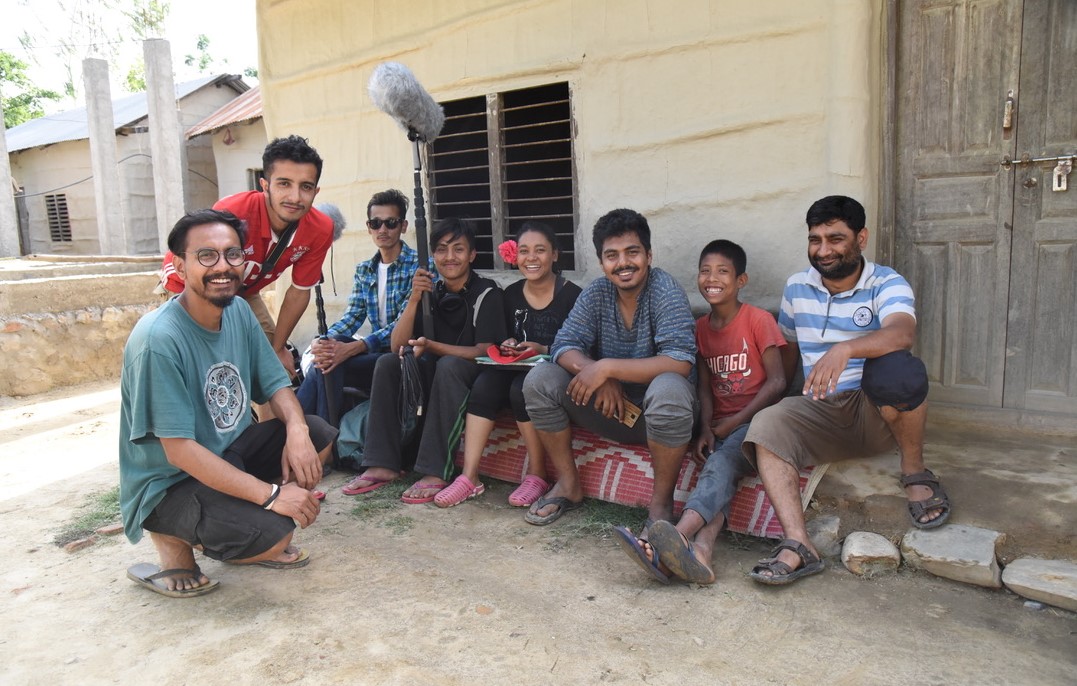
The crew encountered some technical challenges in the course of filming. Babies cried or toddled into the middle of scenes; tractors rattled past in the middle of a heart-felt chat between characters. In a scene where Babuniya goes goat-herding with an older, married friend, played by Shanta Chaudhary (the woman who has rebuffed marriage proposals in real life), the goats kept wandering out of the camera frame. Shree Prasad and I were dispatched to stand nearby and gesture menacingly at them to stay put.
Off-set, I asked Jones and Shree Prasad more about their rationale for the film. Both reiterated that it was important to address spousal violence, because the problem seems to be getting worse. (Of course, accurately determining a trend in domestic violence is difficult since it almost always goes unrecorded, but I asked a handful of village women what they thought, and nearly all of them agreed with Jones and Shree Prasad.)
Jones says that one reason he was surprised by the magnitude of the problem is that Tharu women traditionally held a high status. “I’d say the women always worked harder, but the gap between the workload on the women and the workload on the men, when I lived here, was probably the smallest in all of Nepal,” he told me. He contrasted Ratanpur with a high-caste village in Tanahun district where he also taught, where the women did the bulk of household and farm work, but were treated very poorly.
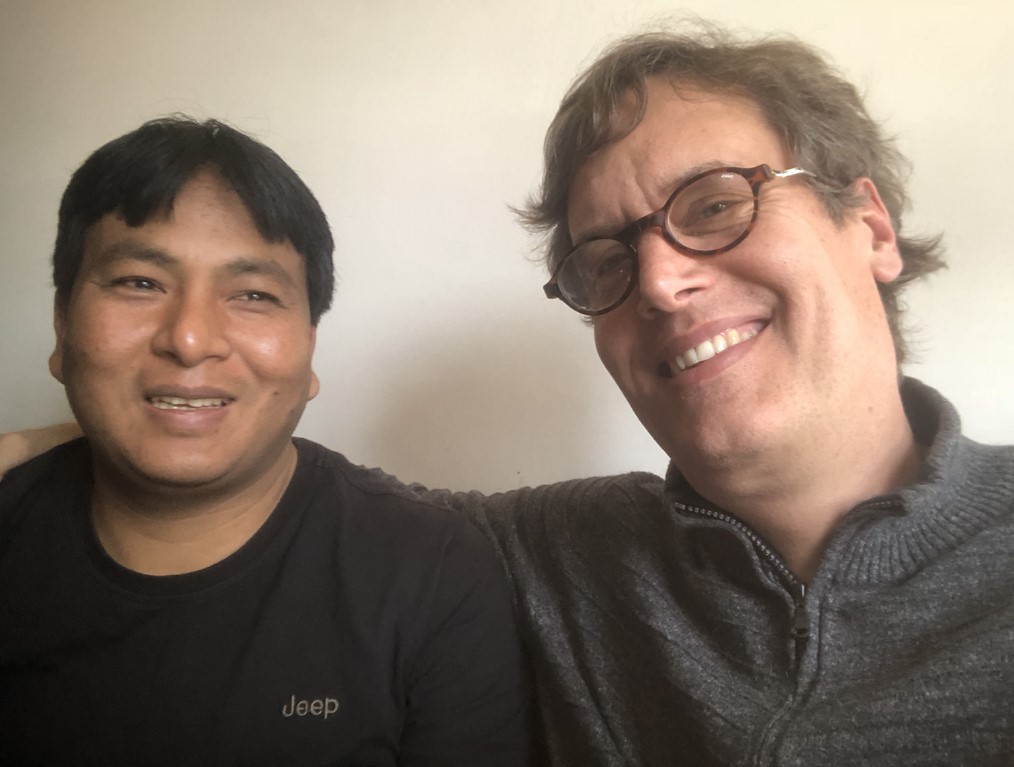 Shree Prasad told me the increase in domestic violence was partly due to alcohol consumption. Although drinking has always been a part of Tharu culture, commercially-produced alcohol has recently become widely available. “Before, you just drank what was available at home. If you didn’t have any, you didn’t drink,” he told me.
Shree Prasad told me the increase in domestic violence was partly due to alcohol consumption. Although drinking has always been a part of Tharu culture, commercially-produced alcohol has recently become widely available. “Before, you just drank what was available at home. If you didn’t have any, you didn’t drink,” he told me.
He said the problem is also connected to a larger societal shift. Like elsewhere in rural Nepal, dependence on agriculture has waned over the past couple decades, as young men, and in some cases women, migrate to cities or abroad to study and earn cash that they send home. Separation leads to distrust between husbands and their wives. Moreover, the shift from subsistence to a cash economy has caused relationships of co-dependence to break down.
“Money determines everything now," Shree Prasad told me. "People think, if I have money, I can do anything.”
Within families, brothers began to quarrel over inheritances more often, and frequently split their joint households. As families divided, there were fewer older relatives like in-laws or grandparents present to intervene when relationships became abusive.
One evening, I took a walk with Jones along the banks of the Rapti. The flood plain is expansive, covered with millions of round river stones, with little vegetation other than a few wispy-flowered grasses. It was near sunset, and on the horizon we saw villagers returning with water buffalo from pastures on the far shore. At a riffle in the river, we came upon an old man, dressed in a beguwa (a traditional loincloth worn by Tharu men) setting a fish trap. He had assembled a V-shaped weir from branches and brushwood that channeled the flow into small woven box, in which the fish, most of them finger-sized, were ensnared.
We remarked that it was nice to see traditional fishing methods still in use. Electrocution and dynamite-fishing have become common, and Shree Prasad’s youngest brother, a shopkeeper in Ratanpur, had lost some fingers in a fishing accident involving explosives.
Seeing the fisherman reminded me of something I had been meaning to ask Jones. Even though the film is set in the present, all the characters wear traditional clothing, rather than the “maxi” dresses or T-shirts that are often seen today, and the scenes feature traditional thatch homes instead of the increasingly common brick ones. Modern technologies are mostly absent, too. There are no mobile phones, and for the water-fetching scene, the team chose to shoot at an old open-air well—one that had been dug by hand, with wooden siding grooved from years of rope-wear—rather than a hand- or electric-pump well, which are more common these days. In short, Ratanpur in the film looks like real-life Ratanpur probably looked decades ago.
Jones told me that he and Pandey wanted to document what is left of traditions before they are lost. “This film is not a documentary, but there’s a lot of stuff in here that’s documenting how the Tharu lived and looked,” he explained.
Still, something about this aesthetic bothered me. Some aspects of modernity are certainly ugly, even detrimental to well-being. But new infrastructure and technologies have undoubtedly made life easier in villages like Ratanpur. Likewise, healthcare and education have become more widely available in recent decades. Educating girls is now the norm, whereas it was uncommon when Jones taught in Ratanpur. By emphasizing the traditional, was the film disavowing real progress?
There is also a long history, throughout the world, of outsiders portraying indigenous people as relics of an earlier age. Colonial-era Orientalist ethnographers portrayed native groups as “uncivilized” and backwards. In the U.S., the photographer Edward S. Curtis—an early influence on the field of “visual anthropology”—took iconic photographs of Native Americans in the early twentieth century that depicted them in traditional attire and scenes, even though many of them led thoroughly modern lives by that time. As a kid growing up in the 1990s, I was used to such depictions, and it surprised me to learn that most Native Americans dressed like me and lived in houses with electricity. Likewise, I had met foreigners and Nepalis in Kathmandu who had never visited Tharu areas, who seemed to have similar misconceptions about them. Didn’t depicting Tharus leading old-fashioned lives in the film reinforce stereotypes?
Jones saw it differently. He told me that he and Pandey didn’t want to re-enforce negative stereotypes at all, and he reminded me that the film’s intended audience is Tharu people themselves.
“I hope that the Tharu[s] can feel proud about how beautiful, and dignified, and just special their culture was. I mean it is too, but was,” Jones said. I recalled the white-haired woman who was so happy to see the Barkha Naach finally performed again. Jones had a point.
Later, I asked Rajeela Shrestha, Pandey’s assistant director, how she felt about the film’s portrayal of tradition and modernity. She compared the film’s emphasis on traditions to efforts by her own Newar people, who are indigenous to the Kathmandu Valley, to preserve their culture. Today, even well-off Newar professionals still take pride in celebrating festivals in traditional attire, performing ancient dances, and cooking traditional food. “We are also doing a lot to try to save our culture,” she told me.
One evening, the film team set out from Shree Prasad’s home to retrieve a wooden boat they needed for a scene. The boat is owned communally by the village, and is used for crossing the Rapti during the monsoon. During the dry season, the villagers store it underwater to preserve the wood, by sinking it in an ox-bow lake along the flood-plain.
The film crew and I had had a few drinks by the time we piled onto the back of a tractor, driven by Shree Prasad’s adolescent nephew, and bounced along a bumpy dirt road towards the lake. It was dark when we arrived, and the boat was invisible under the surface of the water. An initial attempt to tow it out with the tractor failed when the rope snapped. Pandey, Shree Prasad, and several others stripped down to their underwear and jumped in. After much huffing and heaving—and laughing—they managed to flip the large, unwieldy boat over by hand, and then bailed out the remaining water with a bucket. Everyone cheered when the boat emerged from the depths, casting ripples that flashed the moon’s reflection across the water.
The boat appears in the last scene of the film. In the penultimate scene, Babuniya’s husband arrives to take her back to his village. When he shows up, Babuniya refuses to go, despite her parents’ and the community’s protests. But her husband, intuiting her fears, promises he will never harm her. She relents, and they leave together, crossing the Rapti by boat on a sunny morning.
I asked people what impact they thought the film and its message will have once it is screened in the village. (Screening will take place early next year, after editing is finished in Kathmandu.)
Jones was cautiously optimistic. “I hope they will begin to discuss this as a problem that has an effect on everyone in the village,” he told me, adding, “You take a little risk whenever you try to be helpful, and part of that risk is that some additional harm could come to some of the people you are trying to help.”
Shila Tharu, who plays Babuniya, told me, “Smart people will think, ‘it hurts women when we beat them or abuse them.’ But stupid people [who see the film] will just think, ‘these women [actors] have thrown away their dignity.’”
Other women were more hopeful.
Shanta, the unmarried artisan, told me that the village has a double standard regarding violence: if there were a fight in the street between two men, the community would intervene to stop to it. Yet if a man beat his wife at home, most people would turn a blind eye.
Shanta recalled how another woman—the same woman who put chili juice in her husband’s eyes—had ultimately dealt with the problem. Once, after beating her, the husband became so drunk that he passed out. The woman and her son then tied him up by the legs and hung him upside down from a tree in the middle of the village, for all to see. When he woke up, he was mortified, and he never beat her again. The wife had won by forcing the issue out of the home, into the center of public attention. Shanta said she hoped the film would work in a similar way.
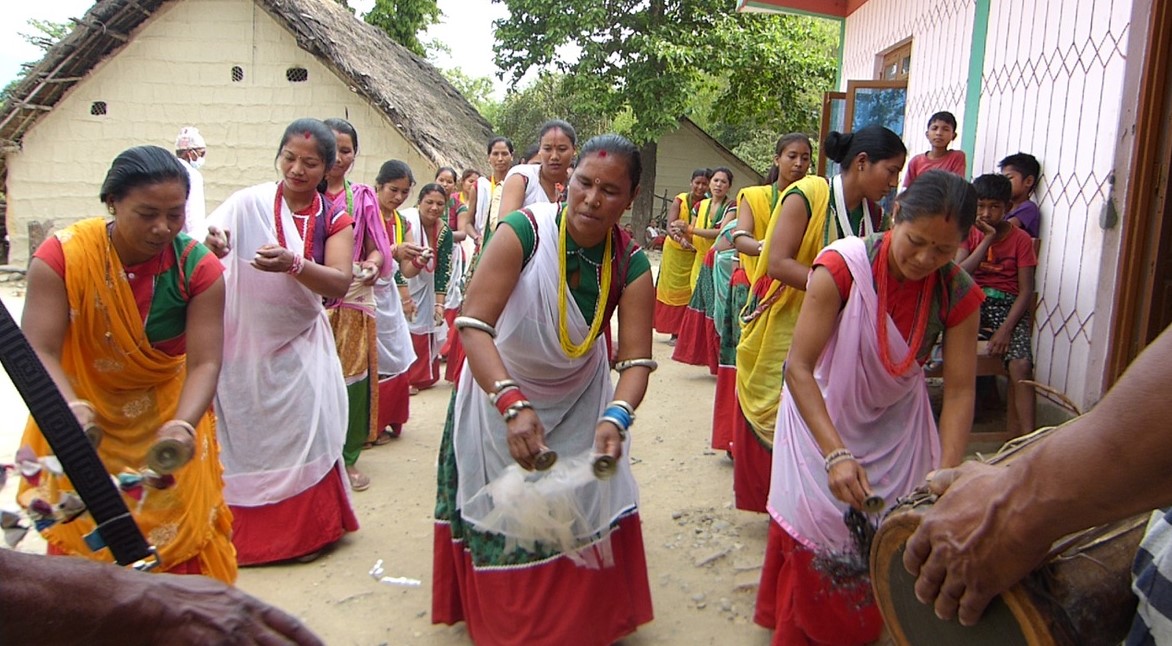
In the late afternoon, the crew and the actors assembled to shoot the Barkha Naach dance scene in front of a home at the north end of Ratanpur. It seemed like the entire village—from the toothless young to the toothless elderly—came out to watch. The drummer sang songs over the deep staccato of his mandhara, as the cinematographer and cameraman circled around, hovering and then darting through the lines of dancers. The younger women who had been timid during initial practices now performed their steps with fluidity. All the women wore their finest yellow and green lehenga-kurta, along with elaborate silver necklaces and other jewelry that gleamed in the sun. They were beautiful, and their faces beamed with confidence.
Peter Gill was a Peace Corps Volunteer in Senegal from 2010-12 and is a journalist based in Nepal. He tweets at @pitaarji






